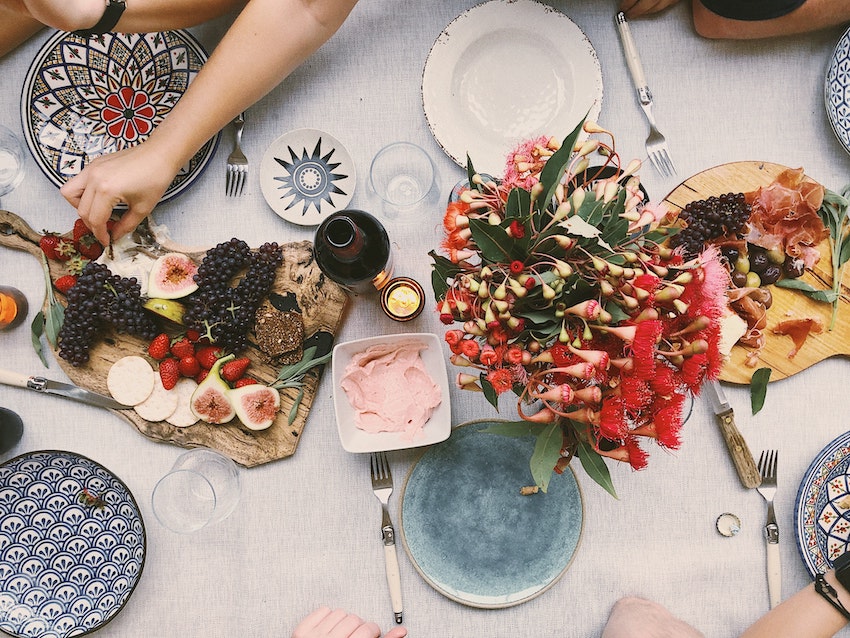
Say No to Festive Food Waste!
With Christmas just around the corner, many of our well-stocked fridges are in danger of bursting at their temperature-controlled seams. If you’re keen to avoid the methane-making madness of rotting food scraps, we might just have the answer – writer Emily Ehlers’ guide to putting your kitchen scraps to tasty use. Yum!
‘Tis the season of family, feasting and… food waste. Yep, I hate to be Grinch-like, but there’s a serious downside to our Christmas buffets and that’s the amount of food we send to the bin afterwards. While a few food scraps here and there may seem like a trifling issue in the fight against climate change, it is most certainly not (unless you are literally putting Christmas trifle in the bin). Here’s the rub: when food rots it produces methane, which is a greenhouse gas 28 times more potent than carbon dioxide. Yikes.
Of course, the best defence we have against festive food wastage is to not buy so much in the first place, to plan well and then to store it appropriately. That said, amidst the Christmas chaos this can be hard to do and we find ourselves facing a fridge full of bin-destined food. However, all is not lost. Where there’s a will, there’s a way.
Get creative with your scraps
The more you learn about food waste, the more you’ll kick yourself for the amount of tasty, nutritious ‘scraps’ you’ve thrown away in the past. Start to notice what you’re throwing out and researching different ways it can be used. Here are some simple ideas to get your brain ticking: when prepping roast vegetables, keep all your peels, ends or slightly limp carrots to throw into a pot for stock. Bones or chicken frames can be added to make your stock into nutritious bone broth, and leftover egg shells can be added for a calcium boost. Banana skins are delicious (not to mention full of potassium and fibre) when used in baking. They can also be the hero of a stir fry or curry, as can broccoli stalks. The white part of your watermelon skin can be made into a tangy, cooling chutney or used as a substitute for cucumber. The leftover brine from chickpeas can be the base for a vegan pavlova. When you start looking at all your scraps as an invitation to get creative, the possibilities are endless.
Pickle those vegetables
The art of pickling has been around since 2030 BC and no surprise – it’s one of the smartest ways to preserve a glut of produce and prevent it from spoiling. Better yet, it’s quick, cheap and easy! Basically any raw vegetables with a bit of crunch can be pickled – think carrots, beetroot, celery, cucumber, radish, cauliflower, onions and more! You’ll be able to find plenty of recipes online, however, I’ll share the basic equation here. Start by putting your veggies in sterile jars. Then add flavours. Whole spices such as garlic, ginger, star anise, peppercorns, mustard seeds, coriander seeds and chilli flakes work well, as do herbs like rosemary or oregano. Top your jars with a heated brine made of 1:1 ratio of water and vinegar, plus a couple of tablespoons each of salt and sugar. Make sure all vegetables stay submerged, refrigerate and leave overnight. That’s it. Not only can you add your pickles to festive cheese platters and sandwiches, but they also make lovely gifts for friends.
Befriend your freezer
One of the biggest tools at your disposal is your freezer – virtually any food can be frozen. Cooked vegetables and leftover meats can be quickly sauteed together and made into homemade freezer meals (all the convenience, none of the packaging). The sauce you choose can dictate the cuisine – a tomato-based casserole, a coconut milk-based curry or a pot luck braised in stock. Any of those would also make a tasty filling wrapped in pastry and frozen like a pie or pastry – perfect for those few days after Christmas when you just can’t be bothered to make anything from scratch. Herbs can be chopped and frozen in your ice cube tray to add for flavourful sautes. Likewise, those fickle avocadoes can be blended with coconut cream and lime for tasty festive smoothie boosters. Learning to use your freezer well extends the shelf life of your food from days to months.
Ho, Ho, OLIO!
If all else fails and you’re still facing an excess of food waste, don’t worry – there’s an app for that. OLIO is an ingenious online food-sharing network where individuals and/or businesses can post ‘listings’ of surplus food for anyone to come and collect. For example, if your fridge was fully stocked but you were leaving on holiday the next day, you could offer the contents of your fridge to anyone who wanted or needed it. Likewise, a local bakery could reduce its waste by offering up the tray of croissants that didn’t sell and thus aren’t quite as fresh (but still completely fine to eat!). This may sound like a strange concept at first, but as the OLIO tagline says: “When did sharing food become weirder than wasting it?”.
Clearly the trick to avoiding food waste is thinking outside the grocery box. Once you’ve got the hang of turning your kitchen trash into tasty treasure, you’ll never look back – so go forth and be scrap-happy, friends!


